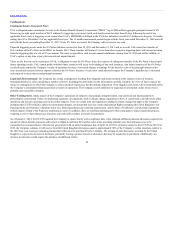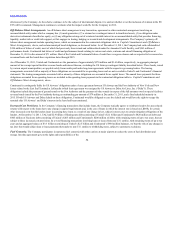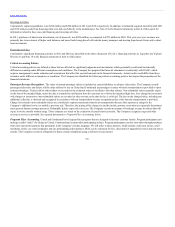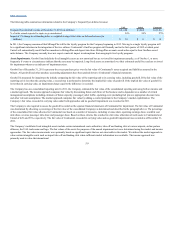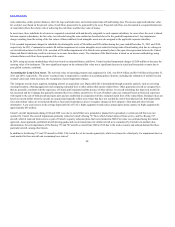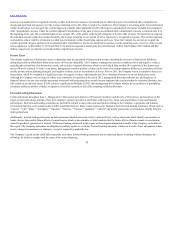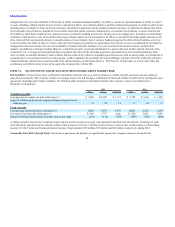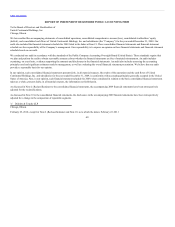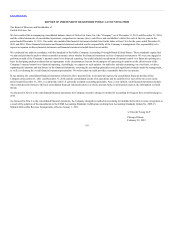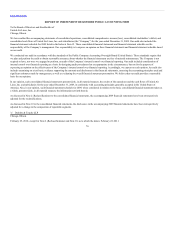United Airlines 2011 Annual Report Download - page 61
Download and view the complete annual report
Please find page 61 of the 2011 United Airlines annual report below. You can navigate through the pages in the report by either clicking on the pages listed below, or by using the keyword search tool below to find specific information within the annual report.
Table of Contents
route authorities, airline partner alliances, the UAL logo and trade name, and certain airport take-off and landing slots. The income approach indicates value
for a subject asset based on the present value of cash flows projected to be generated by the asset. Projected cash flows are discounted at a required market rate
of return that reflects the relative risk of achieving the cash flows and the time value of money.
In most cases, these indefinite-lived assets are separately associated with and directly assignable to each separate subsidiary. In cases where the asset is shared
between separate subsidiaries, the fair value was allocated using the same method as described above for the goodwill impairment test. Any impairment
charges resulting from the testing of the fair values of these indefinite-lived intangible assets are also assigned to the applicable separate subsidiary.
UAL recorded impairment charges for indefinite-lived intangible assets of $4 million and $29 million during the years ended December 31, 2011 and 2010,
respectively. In 2011, Continental recorded a $4 million impairment of certain intangible assets related to foreign take-off and landing slots due to a change in
our slot allocation times. In 2010, UAL recorded a $29 million impairment of its Brazil routes primarily due to the open skies agreement between the United
States and Brazil which may result in a decrease in revenue from these routes. The valuation of the Brazil routes is based on an income methodology using
estimated future cash flows from operation of the routes.
In 2009, using an income methodology which was based on estimated future cash flows, United recorded impairment charges of $150 million to decrease the
carrying value of its tradename. The most significant impact on the estimated fair value was a significant decrease in actual and forecasted revenues due to
poor global economic conditions.
Accounting for Long-Lived Assets. The net book value of operating property and equipment for UAL was $16.4 billion and $16.9 billion at December 31,
2011 and 2010, respectively. The assets’ recorded value is impacted by a number of accounting policy elections, including the estimation of useful lives and
residual values and, when necessary, the recognition of asset impairment charges.
The Company records assets acquired, including aircraft, at acquisition cost. Depreciable life is determined through economic analysis, such as reviewing
existing fleet plans, obtaining appraisals and comparing estimated lives to other airlines that operate similar fleets. Older generation aircraft are assigned lives
that are generally consistent with the experience of United and Continental and the practice of other airlines. As aircraft technology has improved, useful life
has increased and the Company has generally estimated the lives of those aircraft to be 30 years. Residual values are estimated based on historical experience
with regard to the sale of both aircraft and spare parts and are established in conjunction with the estimated useful lives of the related fleets. Residual values are
based on current dollars when the aircraft are acquired and typically reflect asset values that have not reached the end of their physical life. Both depreciable
lives and residual values are revised periodically as facts and circumstances arise to recognize changes in the Company’s fleet plan and other relevant
information. A one year increase in the average depreciable life of UAL’s flight equipment would reduce annual depreciation expense on flight equipment by
approximately $45 million.
United’s aircraft impairments during 2010 and 2009 were due to aircraft that were grounded or planned to be grounded, or certain aircraft that were not
operated by United. The aircraft impairments primarily related to United’s Boeing 737 fleet, which United removed from service, and five Boeing 747
aircraft, which it removed from service as part of United’s capacity reduction plans that were initiated in 2008. Fair value was estimated using the market
approach. Asset appraisals, published aircraft pricing guides and recent transactions for similar aircraft were considered by United in its market value
determination. Several impairments of the Boeing 737 and 747 aircraft occurred from 2008 to 2010 due to the weak economy and reduced demand for these
particular aircraft, among other factors.
In addition to the Boeing 737 and 747 aircraft, in 2009, UAL tested five of its owned regional jets, which were leased to a third party, for impairment due to a
weak market for these aircraft and a remaining lease term of
60





